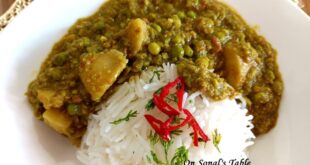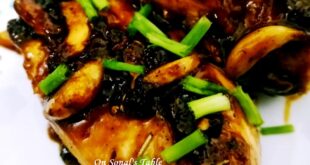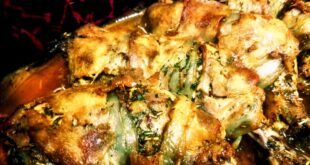As the afternoon melds into the evening, along with dusk come the kids saying, ‘Mom, I’m hungry. You got anything to eat?’
Hmm…What can I say? I am a mother and I have perfected the art of being ready with treats. Its either that or lose my sanity. And I choose the former, thank you very much.
Anyhow, this is one recipe that I love making more often than not. It’s a simple bake and you can tweak it to suit your taste. It lets you experiment quite a bit, trust me.
Now officially this recipe is called ‘Pigs in blankets’. Now, now…don’t laugh! Traditionally pork sausages are used in this recipe and I guess hence the name. But, I used chicken sausages. Hmm…should I be calling it ‘Chicks in blankets’? lol…guess not! That would be too risqué.
So, I am calling this…
LAYERED WITH LOVE
INGREDIENTS
- 12-14 medium sized chicken sausages (at room temperature)
- 2 cups all purpose flour (maida) + ¼ cup (to be used during kneading)
- 2 ¼ tsp instant yeast
- 2 tbsp sugar (regular granulated is good)
- ½ cup lukewarm milk + 1 tbsp for glazing
- 2 tbsp olive oil
- 1 tbsp sesame seeds (optional)
- ¼ tsp table salt
- 1 egg (must be at room temperature)
- Warm water, as per need
- 2 tbsp schezwan sauce (optional)
Note – if you want to omit the egg then increase the quantity of milk. Use ¾ cup instead. This recipe makes about 12-14 pieces.
METHOD
- Activating the yeast – Dissolve the sugar in the milk. Add the yeast to it. The temperature should be lukewarm about 43 deg C or 110 deg F. Too hot or too cold and the yeast will not activate. Mix it well. Cover with a towel and keep aside in a warm place to activate. It should take about 10 minutes. When you see bubbles frothing and the yeast doubling up in size, you’ll know that it has activated.
- Combine the flour and salt. Make a dent in the center and add the egg and oil. Little by little add the yeast solution and knead till you bring it all together. Use a bit of flour of your dough is too sticky. This kneading should table about 10-12 minutes. We are looking for an elastic, supple tendency in the dough.
- Once done, transfer the dough to a greased dish. Cover it with a wet cloth and keep it in a warm place to rise. This should take about an hour. You can keep it for 40 minutes also but I really prefer to let it proof for an hour.
- After an hour the dough will double in size. Knock it down and knead it till it again comes back to its original volume. It should be springy to the touch.
- Divide the dough into four parts. Grease the kitchen platform and your rolling pin and roll out one part about 1 mm think. Brush some schezwan sauce or any other of your choice and cut the dough (with a pizza cutter) into 1 ½ inch strips.
- Wrap a sausage in each strip and place on a greased baking tray. Keep a 2 inch distance between the pieces because they will double in size. Make sure the sausages are thawed and are patted dry of excess moisture.
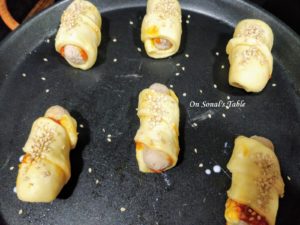
- Glaze with some milk (just brush the top side with some milk) and sprinkle some sesame seeds.
- Pre heat the oven to 180 deg C.
- Bake for 20-22 minutes at 180 deg C. In an oven (not microwave oven) it will take about 15 minutes so keep a check.
- Note – if you would like to make buns instead of rolls then just make round balls about of 2 inches diameter and bake for the same amount of time. You can also stuff them with mince or kebabs.
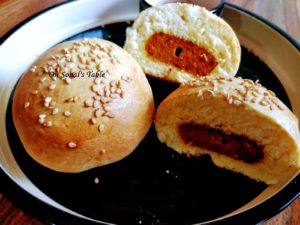
- Serve hot.
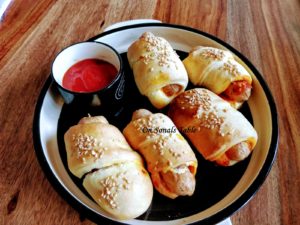
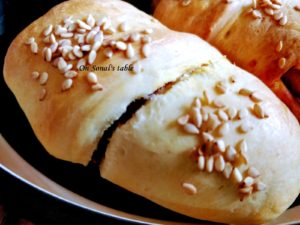
 Sonal Singh On Sonal's Table
Sonal Singh On Sonal's Table

